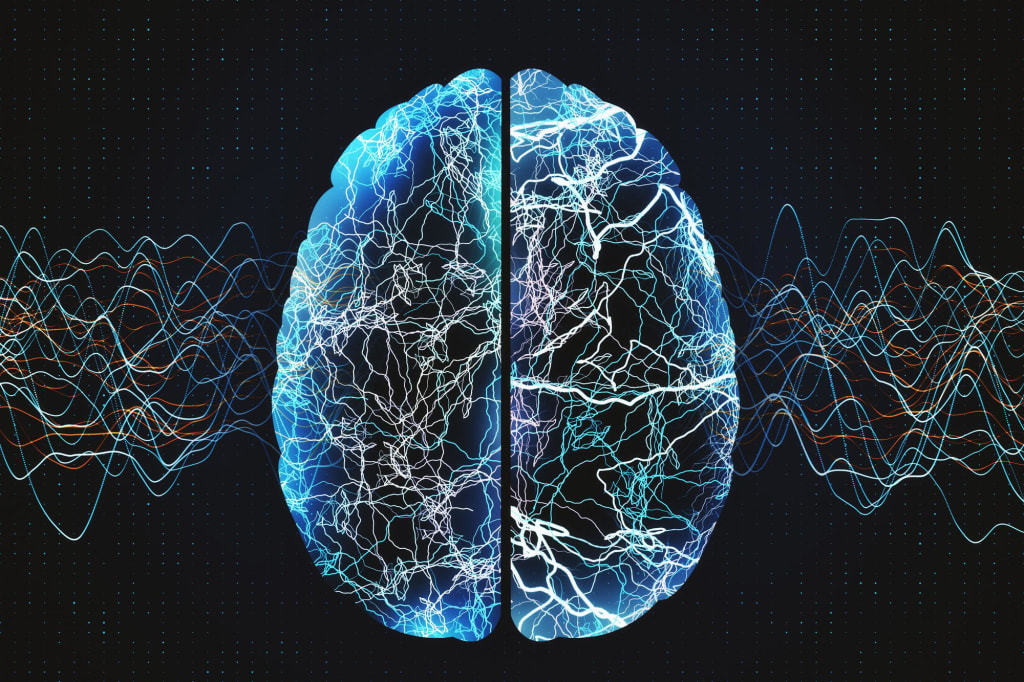Archimedes' Eureka Moment and the Mystery of Brain Waves
Archimedes' Eureka and the Science of Brain Waves

## Archimedes' Eureka and the Science of Brain Waves
### The Eureka Moment: Archimedes' Story
About 2,300 years ago, in Syracuse, Sicily, three elderly women sat on a bench in the town square, chatting as old friends do on a warm Mediterranean day. Suddenly, loud shouts of "I've got it! I've got it!" broke through the morning air. The women looked across the square to see a young man running towards them at high speed. As he got closer, they realized he was stark naked.
"You certainly have got it," thought the first old lady to herself, then she had a stroke. The second old lady also had a stroke. The third old lady almost had a stroke too, but her arms were too short. The crazy streaker running through town that day was Archimedes, the celebrated physicist, mathematician, astronomer, inventor, engineer, and exhibitionist. The reason he was shouting "Eureka!" or "I've got it!" was not because he wanted the world to know he had a large package, but because he had just solved a nagging physics problem.
Only a few minutes before, Archimedes had been climbing into the bath. As he did so, he noticed the water level rising and had a sudden flash of insight, or as it subsequently became known, a "eureka moment." In that instant of clarity, Archimedes understood the principle of displacement and realized he'd found a way to measure the volume of a gold crown and, by extension, its density.
The crown in question belonged to the King of Syracuse, who, suspecting his goldsmith of cheating him, wanted Archimedes to devise a way to test whether the crown had been made of solid gold as required or gold mixed with silver. By dividing the mass of the crown by the volume of water displaced, Archimedes was able to determine the crown's density. Since it was lower than it should have been, he proved the goldsmith was lying.
### The Power of Eureka Moments
You've probably had a few eureka moments yourself. These moments, also known as "aha moments," have delivered some of humankind's most radical breakthroughs. The theory of gravity dawned on Isaac Newton as he watched apples fall from a tree. Albert Einstein finally distilled the theory of general relativity while riding on a tram. August Kekulé saw the chemical structure of benzene as he nodded off in front of a fire. Arthur Fry thought up the Post-it note in church.
Exactly how this process works has always been a bit of a mystery. The eureka moment is similar to the type of divine inspiration artists yearn for. It's unpredictable and can't be manufactured. However, neuroscientists studying insight have discovered that strokes of genius have a very clear signal in the brain and can be encouraged by creating just the right neurological conditions. It all comes down to brain waves.
### Understanding Brain Waves
Brain waves are the product of the brain's electrochemical function. The mass of grey matter in your skull contains billions of neurons (nerve cells) that receive and send electrical signals throughout the body. On average, each neuron connects to thousands of others, and they communicate through small electrical currents that travel along the neurons and throughout enormous networks of brain circuits. When neurons are activated and synchronized, they produce electrical pulses. The rhythm of these pulses forms oscillations called brain waves.
When many neurons interact in this way at the same time, the activity is so strong that it can be detected even outside the brain. By placing electrodes on the scalp, brain activity can be measured, amplified, and visualized. This is electroencephalography or EEG. Like most waveforms, brain waves are generally measured in terms of their amplitude (depth) and their frequency (the number of oscillations in a given period of time). There are five main brainwave patterns categorized according to their frequency, named after letters of the Greek alphabet: gamma, beta, alpha, theta, and delta.
### Types of Brain Waves and Their Functions
Gamma waves are widely regarded as the fastest waves produced by the brain, with a frequency of 26 to 100 Hz. They're quite rare, tend to have a high impact for a short amount of time, and are associated with episodes of heightened perception, insight, and intuition. Mark Beeman, a neuroscientist at Northwestern University, and John Kounios of Drexel University pioneered research into the eureka moment using fMRI and EEG machines. They discovered that about a third of a second before a person has a sudden flash of understanding, the brain sees a massive spike of gamma wave activity.
Beta waves, occurring in the 13 to 32 Hz frequency range, are associated with our normal waking state and suggest alertness and active thinking. Beta waves are present when we're focused on a task, engaged in conversation, trying to solve a problem, or making a decision. It's the brainwave pattern usually present when we're busy and thinking of a hundred different things.
Alpha waves, slightly slower than beta waves, occur in the 8 to 13 Hz range. These were the first brain waves to be discovered and occur when we're physically or mentally relaxed. They're often connected with higher levels of serotonin, one of the feel-good hormones, and are frequently present during episodes of artistic creativity, awareness, and light meditation.
Theta waves, between 4 and 8 Hz, naturally occur when we're daydreaming, falling asleep, or in REM sleep. They're also found when people are in deep meditation or doing something that allows the brain to go into autopilot, like brushing your teeth. Research has shown a positive association between theta waves and memory, creativity, and psychological well-being.
Delta waves, the slowest waves conventionally recognized, are found between 0.5 and 4 Hz. They're strongest when we're in a deep, dreamless sleep—the time during the night that our brain and body are dedicated to rejuvenation. Your brain needs to spend time in this state to repair itself from the stresses of daily life.
### Advanced Brain Wave Research
As this field of research expands, some claim to have found fringe brainwave frequencies like epsilon waves that oscillate between half a cycle a second and as low as one quarter cycle every 10 seconds. These super slow frequencies were theorized after studying yogis and long-time meditators and are thought to accompany the controversial yogic state of suspended animation, in which the practitioner has no discernible pulse or breathing—essentially, a state of suspended life.
Lambda brainwaves, extremely fast frequencies almost twice as fast as gamma waves at about 200 Hz, are at the opposite end of the spectrum from the slow epsilon waves. Apparently, if you zoom in really far into an epsilon wave, you can see high-frequency oscillations of lambda waves riding the epsilon wave—waves within waves, like inception but while you're awake. Lambda waves are thought to be connected with transcendental states and out-of-body experiences.
### Practical Applications of Brain Wave Knowledge
For now, all this talk about epsilon and lambda is speculative. They're extremely difficult to measure, and unlike the five primary brainwave patterns, there is very little scientific data to support any clear conclusions. However, the science and technology used to measure brain waves can also be used to reverse-engineer the brain states associated with those wave patterns.
Remember those monks who achieved advanced mind states and showed almost constant gamma brain waves? They achieved that through training their brains, even though they had little interest in brain waves. Now, neurofeedback tools can show people their brain waves in real-time, helping them train their minds by changing their brainwave patterns and finding optimal states of consciousness. Technologies like binaural beats claim to use audio frequencies to stimulate certain brainwave patterns, encouraging your mind to experience an associated state. For example, listening to an alpha brainwave track might encourage your brain to synchronize with the alpha rhythm, tricking your mind into thinking you're tanning on a beach in Bali.
### The Social Aspect of Brain Waves
Brain waves only reflect underlying mind states and behaviors; they don't cause them. However, if we're able to influence our brainwave patterns, we're influencing our mental states too, possibly allowing us to choose which mental state we operate in. The ability to change your mind state at will to meet the needs of whatever situation you're in would be like having a superpower.
Furthermore, a growing body of research shows we can influence each other's mental states too. One study conducted by the Basque Center on Cognition, Brain, and Language reveals that the rhythms of brain waves between two people taking part in a conversation begin to match each other. In separate research, Princeton University neuroscientist Uri Hasson has shown that the stronger the connection between two people, the more their brains click—they literally get on the same wavelength. Another study in New York suggested that the brains of people in the same group tend to be in sync, making them like each other more and enjoy the experiences they share together more fully.
### Conclusion
This field, known as interactive social neuroscience, is still new, so there's a lot to understand. However, it has the potential to show what happens neurologically when we behave a certain way or connect with other people. With that information and a lot of practice, who knows? Perhaps you could not only master your own mind but also the minds of others too. Essentially, you could become a modern-day Yoda—only taller. And that's pretty cool.
About the Creator
Enjoyed the story? Support the Creator.
Subscribe for free to receive all their stories in your feed. You could also pledge your support or give them a one-off tip, letting them know you appreciate their work.





Comments
There are no comments for this story
Be the first to respond and start the conversation.